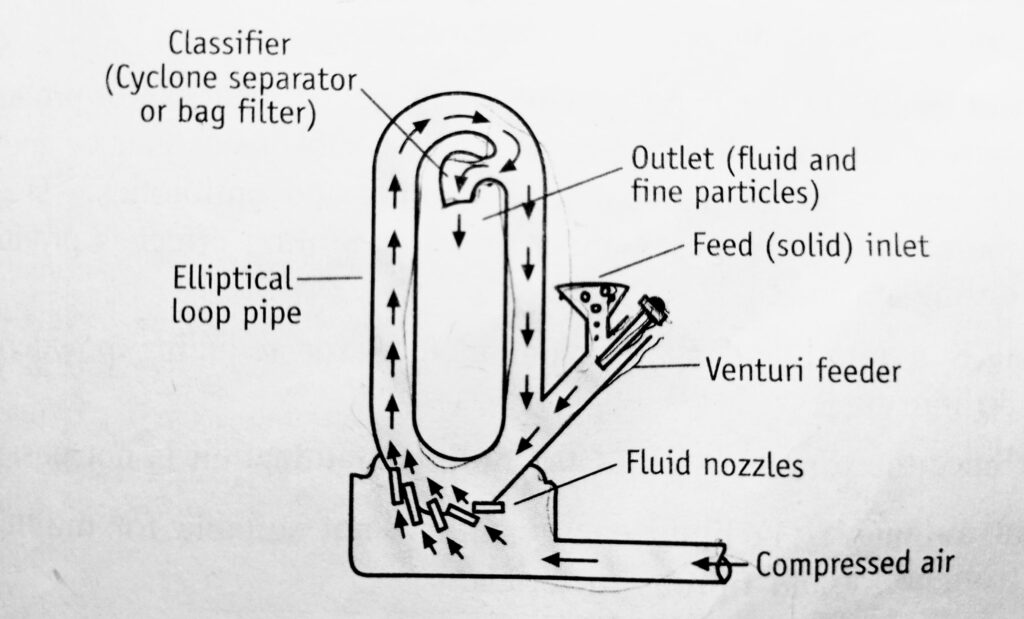Table of Contents
Principle of Fluid Energy Mill
The fluid energy mill operates on the principle of impact and attrition. In this equipment, the feedstock is suspended within a high-velocity air stream. Milling takes place because of high-velocity collisions between the suspended particles.
Construction of Fluid Energy Mill
The construction of a fluid energy mill is shown in Figure 1.1. A fluid energy mill consists of an elliptical pipe, which has a height of about 2 meters and a diameter ranging from 20 to 200 millimeters. The mill surface may be made of either soft stainless steel or tough ceramics. Usually, mills are constructed such that the contact surfaces are merely linings, which can be removed or replaced if excessively eroded after use.
Grinding nozzles (usually two to six) may be placed tangential and/or opposed to the initial flow path of a powder. Normally, compressed air of 600 kilopascals to 1.0 megapascals is used. Inert gases can be used to minimize or eliminate the oxidation of susceptible compounds Venturi feeder is provided in the path of the airflow. An outlet with a classifier (cyclone separator or bag filter) is fitted to allow the escape of air.

Working Fluid Energy Mill
The powder is introduced through the inlet of the venturi. The air entering through the grinding nozzles transports the powder in the elliptical or circular track of the mill. In the turbulent stream of air, the suspended particles collide with each other and break. Thus, impact and attrition forces operate in size reduction. The resultant small particles (entrapped by air) are carried to the outlet and removed by cyclone separator or bag filters.
The coarser particles undergo re-circulation in the chamber on account of their own weight. These re-circulated particles collide again with new incoming feedstock particles. The powder remains in the mill until its size is reduced sufficiently. Later it leaves via the sieve. Hence, the fluid energy mill produces particles with narrow size distribution. Sometimes the particles, are entrapped by the drag of gas. leave the mill and carried out to a cyclone separator or bag collector for size separation.
Uses: Fluid energy mill is used to reduce the particle size of most drugs such as antibiotics and vitamins. When strict quality control is desirable for the purpose of better absorption (bioavailability), this mill is the preferred one. Ultrafine grinding can be achieved. Moderately hard materials can be processed for size reduction.
Advantages of the Fluid Energy Mill
- It has no moving parts, hence, heat is not produced during milling. Therefore, heat-labile substances can be milled. Examples are sulphonamides, vitamins, and antibiotics. Due to the expansion of gases under pressure cooling effect is produced during milling.
- It is a rapid and efficient method for reducing powders to 30 mm or less.
- Since there is no wear of the mill, contamination is not possible.
Disadvantages of Fluid Energy Mill
- This mill is not suitable for milling soft, tacky, and fibrous materials.
- The equipment is expensive because it needs additional accessories, particularly fluid energy sources and dust collection equipment.
Variants: Centrifugal-impact pulverizer-In centrifugal impact pulverizers, a rotor is spun to induce high centrifugal force on the feed particles. The particles move towards the impactors, which are set at the periphery of the rotor. On striking these impactors, the material is further hurled against the outer casing where final reduction is achieved. The material is removed from the conical discharge at the bottom.
Particle size reduction in the range of 10 to 325 meshes can be obtained with this type of mill with minimum fines. Centrifugal impact pulverizers have been used for the size reduction of a variety of materials ranging from soft organic molecules to hard abrasive materials. It is also well suited for the size reduction of heat-sensitive materials.
Make sure you also check our other amazing Article on : Tablet Compression Machine
